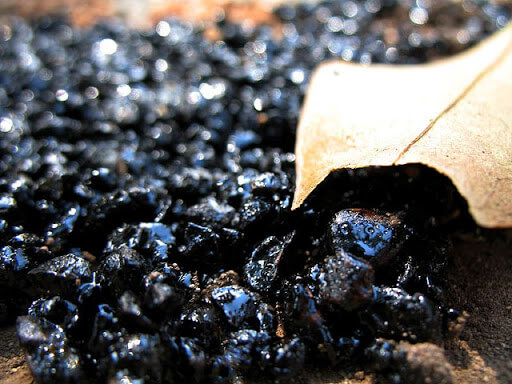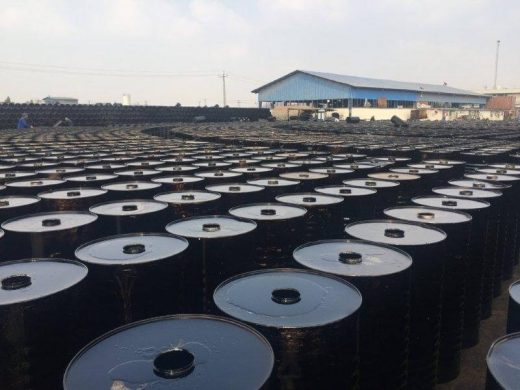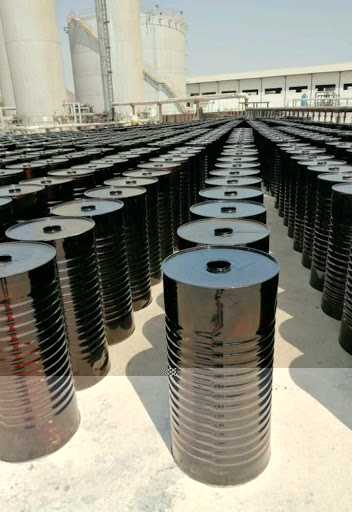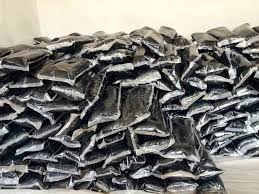Introduction
Bitumen is obtained from the fractional distillation of crude petroleum. It has adhesive properties, and it has added oil while manufacturing the names of kerosene, spirit, volatile oils, etc. It is most widely used on roads as it is an excellent binder and binds the materials for durability, recyclability, and usability for roads. It is used widely used for the construction of flexible pavements. It has excellent waterproofing properties, low-cost material, and is dark or black. It is often confused with tar as it has similar properties. Tar is obtained by destructive distillation such as coal or wood, while bitumen is not. Apart from this, bitumen is soluble in carbon disulphide, and tar is soluble in benzene or nitrobenzene. It’s scope in improvement is limitless as it has flexibility in properties and is expected to be environment friendly during the course of time. All these properties and the effectiveness of bitumen are discussed here in this article.

Fig 1: Bitumen
Courtesy: Raha Bitumen
Properties of Bitumen
Some of the properties of bitumen are –
- The melting point of bitumen is 300 to 800 Celsius. This melting point is obtained by ring and ball apparatus in the laboratory. This property makes bitumen safe enough to not become too hot for the vehicles crossing on top of it. In some countries, this range can exceed. Still, the road aggregates and other materials below the bitumen pavement ensure that the balance is maintained, and the bitumen can also tolerate so higher temperature.
- Bitumen can easily be recycled as it doesn’t destruct itself. In case bitumen is recycled, the bitumen on roads can be detached from aggregates by high heating temperature. This will be sent to the laboratory for the further recycling process. Then, the old asphalt is mixed with this new bitumen to lay a more robust layer on the road.
- Bitumen is composed of hydrocarbons and is non-toxic. The material is pure and is safe to be used on the road. Crude oil, which is its raw material, is formed from decayed organic material. Hence, it is safer compared to other road materials.
- Bitumen is available not only in black colour but also in coloured forms. Some pigments can be added in the process of formation to deliver coloured bitumen. Some chemicals additives are required for this and are pretty costly. Thus, it serves a particular purpose other than roads.
Types of Bitumen
There are various types of bitumen that have variations in their properties. Some of them are –
1.Viscosity Graded Bitumen is one such bitumen based on absolute viscosity at 60 ºC or a kinematic viscosity at 135 ºC. It is used in the form of paving grade bitumen for producing asphalt pavements that are used in road constructions.

Fig 2: Viscosity Graded Bitumen
Courtesy: Pars Universal Bitumen
2. Performance Graded Bitumen – Here, the temperature is the main factor that produces varying properties in bitumen, allowing customers to select or customize their needs in implementation. Such type of bitumen is restrained to fully characterize asphalt binder for use in Hot Mix Asphalt (HMA) pavement.

Fig 3: Performance Graded Bitumen
Courtesy: HJ OIL Group
3. Penetration Graded Bitumen – It is classified based on the needle’s depth of penetration under particular test conditions. The penetration of a needle in bitumen indicates how stiff the bitumen is. More penetration implies a stiffer bitumen. It is specified as 50/70, which means 50 mm to 70 mm penetration under standard test conditions.

Fig 4: Penetration Graded Bitumen
Courtesy: Sahara Business Group
4. Oxidized Graded Bitumen – The properties of bitumen can be changed by allowing air to pass through it by increasing temperature. The extent of the oxidation process can vary from small, often known as air-rectification, or semi-blowing, which has a slight impact on bitumen’s properties, to the whole blowing, where the properties are entirely altered. Naming and grading are based on a combination of the bitumen softening temperature when heated up, as expressed by the ring and ball softening point test and the penetration value.

Fig 5: Oxidized Bitumen
Courtesy: ATDM. CO. LTD
5. Polymer Modified Bitumen is a mixture where the polymers alter the visco-elastic property of bitumen and transform it into a more suitable binder to handle different stress levels. The most common one is the styrene–butadiene–styrene (SBS), followed by other polymers such as styrene-butadiene–rubber (SBR), ethylene-vinyl-acetate (EVA), and polyethylene. One drawback is that they are costlier than pure bitumen, but on the other side these are more economical because of economic benefits for road repairs involving low costs.

Fig 6: Polymer Modified Bitumen
Courtesy: Bitumen Emulsion- Globecore
Conclusion
Bitumen has been used in construction for a long time, ever since the road-making process has evolved. It does occur naturally, but when used as a binder on roads, it is added with some chemicals under standard conditions to improve its suitability. Researches are being made to produce more environment-friendly bitumen that has low carbon emissions and other harmful substances. Also, improvements are being made in bitumen properties so that in asphalt roads, it does not rip off easily, and more durable roads are generated. Although concrete blocks are taking over the market, it is still a primary choice in many countries due to its flexibility in changing properties. Nanostructures like nanotubes, graphene, ceramic, etc., are also used as additives in some areas, and they have proved to deliver the best results. New tests are also being processed to study deeply the bitumen properties that can be more effective in the construction industry. Hence, with the advent of time, it can be expected that the bitumen will solve all the problems ongoing in the field that require special attention by experts.
References
RAHA Bitumen Co, “Bitumen Types”- http://rahabitumen.com/bitumen-types
Lone Star Paving, “Why Is Bitumen Used In Road Construction?”- https://www.lonestarpavingtx.com/why-is-bitumen-used-in-road-construction/
BuildersMART, “Applications & Uses of Bitumen in Construction”- https://www.buildersmart.in/blogs/bitumen/
Civil Engineering Notes, “Introduction To Bitumen As Pavement Materials”- https://www.civilenggnotes.in/introduction-to-bitumen-as-pavement-materials
Bitumina Hi-Tech Pavement Binders, “Viscosity Grade Bitumen (Asphalt)”- http://www.bitumina.co.uk/viscosity-bitumen.html
If you have a query, you can ask a question here.


